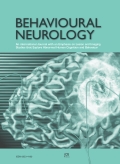Authors: Stracciari, Andrea | Fonti, Cristina | Guarino, Maria
Article Type:
Research Article
Abstract:
We report the clinical findings and neuropsychological profiles of a sample of patients exhibiting a focal retrograde amnesia (FRA) seen consecutively during the period 1992–2007. The cohort comprised 13 patients, five males, with a mean age of 30 years (range 16–49). They were given a neurologic examination, psychiatric interview and formal neuropsychological examination (all but one) during the amnesic phase, underwent neuroimaging, and were followed up for six months to ten years. All presented with an
…acute amnesia characterized by an impaired recollection of memories predating the acute event, with spared or minimally and transiently affected anterograde memory, thus consistent with FRA. The events triggering FRA varied widely: mild to severe head injury, road accident without head injury, seizure, dissociative fugue, BDZ overdose, posttraumatic headache, syncope, migraine attack, acute distress. The neuropsychological hallmark of FRA was a selective or prominent impairment of autobiographical memory. The defect was often so severe as to cover most or all of the patients' lives and, in some cases, to erase the knowledge of their own identity. Conventional neuroimaging (brain CT and MRI) was unimpressive. Cerebral SPECT/PET disclosed unilateral frontal hypoperfusion in three (two left). All but one patient fully recovered, time of recovery ranging from three days to six months. FRA is a condition reflecting a block of memory function triggered by heterogeneous events, including both physical and psychic insults. Analogies shared with the more frequently encountered and better known condition of transient global amnesia suggests common pathogenetic mechanisms. A tentative nosographic classification of FRA is finally offered.
Show more
Keywords: Amnesia, focal retrograde amnesia, psychogenic amnesia, functional amnesia, transient global amnesia
DOI: 10.3233/BEN-2008-0222
Citation: Behavioural Neurology,
vol. 20, no. 3-4, pp. 113-125, 2008
Price: EUR 27.50




